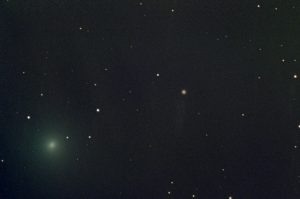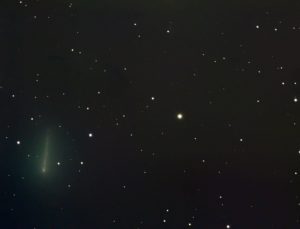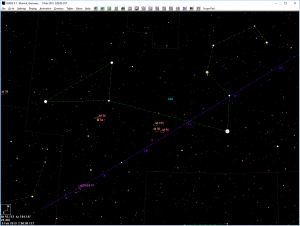There was a lucky break in the storm of about 45 minutes to see Comet ‘C2018 Y1/Iwamoto’ after midnight 19/02!11.
Just enough time for a snapshot during a heavy winter storm nore ore less out of a roof skylight photgraphed in an area with heavy light polution. Conviniently the iceball just raced by my field of view.
On the left lifestacking in cloud gaps. TMB80 600 mm, Infinity 65x20s. The bright tail is the core because its starstacking.
On the left thats’s how it looks after with my limited skills of PixInsight Cometstacking.
In the next few days its brightness is expected to increase even further; it reaches its maximum brightness of about 6.5 mag by the 12th of February (today), when it approaches Earth at 0.3 astronomical units (30 percent of the Earth-Sun mean distance).
Comet ‘C / 2018 Y1’ Brightness = 6.4mag
Best visible between 19.0h – 6.0h clock (h top = 59 ° in the S at 0.7h clock) (in the constellation Leo)
RA = 10h02m09s Dec = + 17 ° 20.9 ‘(J2000), hourly movement: 1071.8 “/ h position angle = 302.6 ° dRA = -64.4sec / h dDec = 561.9” / h, distance to the Sun = 1.29AE, distance to Earth = 0.30AE, elongation = 174 °, h = 15.0 ° az = 80.7 ° / E, sun altitude = -16 °, elongation of the moon = 96 °, moon height = 53 ° SSW, moon phase = 48%
Position angle gas tail = 173 ° (with respect to zenith = 216 °), length of a 0.06AE long tail = 29 ‘, position angle dust web (not tails) = 121 ° (with respect to zenith = 165 °), orbit direction = 91 ° (almost parallel dusty path would be long but weak), width of the earth above the orbital plane = 4 ° (earth near the orbital plane – possible tail relatively easy to see)
This is not enough for visibility with the naked eye, but with binoculars it should be easy to find. Not today, its cloudy but the weather report talks of early taste spring.
Her a short movie of the 65 pictures.



